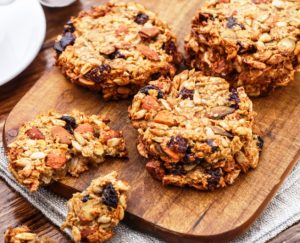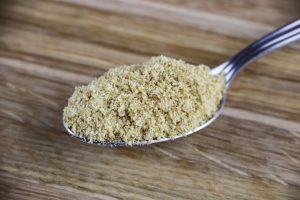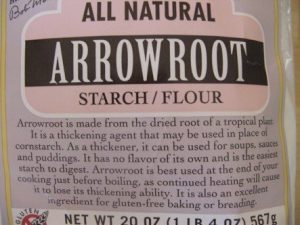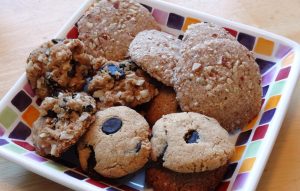Cooking with gluten-free flours can be tricky but it is worth it. Imagine eating sinfully delicious desserts that are also healthy for you!
When you are just eating gluten-free whole grains, it is relatively simple. You can just throw some rice or millet in a pot, and with a little variation on the amount of water; you can get a pretty good meal. If you want to cook perfect millet or rice every time, it is more precise but for many, this is not absolutely necessary.

Once you get into baking though, it’s a whole new level of complexity and precision to get that perfect cookie or cake. You can’t just substitute your favorite regular wheat recipe with rice flour for example. It just won’t work out. I often feel like a chemist in the kitchen fine tuning gluten-free recipes.
The first step is to have the proper gluten-free flours.
To keep it simple I have limited this list to a handful of my favourites which I use all of the time. I was extremely sensitive to gluten and almost everything so I have been cooking and baking gluten-free for almost 20 years.
All my recipes are also 100% white sugar-free and 100% unhealthy starch free. Many of the common gluten-free recipes and products are loaded with sugar and starch and that is definitely not healthy.
Healthy Gluten-Free Flours I Use for Specific Reasons
Grain Flours
Brown Rice Flour
- Has become a stable in my baking
- Add fiber and nutrition
- Assists in weight loss, helps reduce cholesterol and balances energy
- Add somewhat dry gritty crumbly texture
- Low cost
- Read Brown Rice vs White: Benefits and Cautions
White Rice Flour
- Use for shortbread and pastry
- Add lightness and texture
- Add somewhat dry gritty crumbly texture
- Works best when combined with high protein flours to balance texture and build structure
Caution: Use only small amounts as it has less nutrition than brown and is tending to be starchy.
Rolled Oats
- High in fiber, protein and nutrition
- Add taste, texture and structure
-
Contains lignans which protect against heart disease and cancer.
- Read many more benefits at 10 Benefits of Oatmeal
Caution: Often contaminated with wheat so must buy special gluten-free oats and flour
Nuts (for gluten-free baking)
These two have become favourites in my baking for grain-free recipes.
Blanched Almond Flour/Meal
- Add a sweet, nutty flavour
- Add protein, fiber, vitamin E and healthy fat
- Adds structure and texture
Caution: It is high in fat and can go rancid easily so keep refrigerated or freeze if not using within a few months.
Coconut Flour
- Low-carb, high-fiber flour
- A subtle, sweet fragrance
- Well tolerated by those with allergies
Caution: It is a very dense flour to use 100% without eggs or flax meal.
Beans Flour
Chick Pea Flour
- Adds moisture, good texture, high protein and high nutrition.
- It is creamy coloured with a slightly sweet bean taste.
Caution: Never use more than 30% of the mixture due to the bitter aftertaste.
Seed Flour

Golden Flax Meal
- High in fiber and omega-3 fatty acids
- A mixture of flaxseed meal and warm water is used as an egg replacer in vegan and egg-free baking.
- A healthy substitute for xanthan gum or guar gum
Caution: They can cause a flecked appearance and too much can have a laxative effect so introduce slowly.
Tubers and Root Flours
Potato Flour
- High in fibre and protein
- Fine creamy white-yellow powder
- Made from dehydrated whole potatoes
- A healthy substitute for xanthan gum or guar gum
Cautions: Don’t confuse with potato starch. Use much less.

- Well tolerated by food-allergic people, even those with multiple allergies
- High nutritional properties enhance baking performance
- Chewy texture and increased browning capabilities
- One of the few healthy starches- read my article Arrowroot Flour for Healthy Gluten-Free Baking
Caution: Too much (over 25%) can produce a gummy texture.
Vegan Egg Substitutes
The last 4 items on the list above, chickpea flour, flax meal, potato flour, and arrowroot flour can be used as an egg substitute in your baking.
Read: 9 Vegan Egg Substitutes
There are many more gluten-free flours but these are the basics.
I am always experimenting with new gluten-free flours and combinations. I play with millet, sorghum, quinoa, amaranth, teff, buckwheat and even ancient wheat. Most of those grains are already in my diet and I love them. I must be careful when teaching to not overload but I like to play and experiment myself. Suggestions of YOUR favorites are welcome.
Our diet needs to consist of is a wide variety of foods; not just the same ones over and over every day. Sometimes the same food is eaten many times a day like wheat which comes as toast for breakfast, muffins for tea, a sandwich for lunch and then pasta for dinner and cake or cookies for dessert. I believe that is one of the reasons so many have an intolerance for the gluten in wheat.
I am also passionate about creating more healthy gluten-free recipes.
You can read my rant about this here: 9 Dangers of Common Gluten-Free Products and Recipes
Many popular recipes and products are filled with sugar and starch. Almost everyone knows the dangers of too much white sugar but many people don’t know that starch is very similar to sugar. It has almost no vitamins and minerals, and extremely low amounts of fiber, and protein. Read all the difference here: Starches VS Flours – What is the Difference
That’s why all my recipes are filled with only healthy flours and ingredients.
That is why I teach a special Healthy Baking BootCamp
This is for people to get not only the knowledge but also the skills to bake and cook properly with gluten-free foods. It has the focus and success of a gritty outdoor boot camp so in one weekend you get to create sinfully delicious AND healthy desserts…but from the comfort of your home.
Check it out here: Healthy Baking BootCamp
Note: If you are considering going gluten-free
- Read: Can a Gluten-Free Diet Help You Lose Weight?
- Read 11 Gluten-Free Grains to learn some of the alternatives and their many benefits.
- Check out: Diana’s Gluten-Free Recipes Make sure you are subscribed to the newsletters for the latest recipes.



Is there something I should watch because I have type 2 diabetis and, for example,I have to stay away from pasta. My doctor also told me that, if I would loose 20 lbs I would have no need for insulin
That’s a well written and insightful article. I am sure I will take a lot of pointers from here! Cheers!!